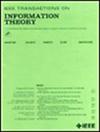随机阶梯生成器矩阵代码:编码定理、性能分析和代码设计
IF 2.2
3区 计算机科学
Q3 COMPUTER SCIENCE, INFORMATION SYSTEMS
引用次数: 0
摘要
本文提出了一类具有阶梯状生成器矩阵的随机阶梯生成器矩阵码(SGMCs)。在无限长区域,我们证明了随机SGMC在二进制输入输出对称(BIOS)通道上是容量实现的。在有限长度区域,我们提出了sgmc的局部约束广义代表性有序统计解码(LC-ROSD)算法。具有LC-ROSD的sgmc最显著的特点是,阶梯状矩阵可以并行实现高斯消去(GE),避免了传统OSD的串行GE,并支持潜在的低解码延迟,从模拟中可以看出。为了分析有限长度区域随机sgmc的性能,我们推导了集合权谱,并调用了常规的联合界。我们还推导了一个比传统的RCU界更严格的部分随机编码联合界,并将其作为设计sgmc的标准。阶梯式生成器矩阵允许我们基于二阶Bonferroni不等式,随着码字数量的增加,推导出一系列(越来越紧密的)下界。数值结果表明,在不同码率和不同轮廓下,所提出的部分RCU绑定的译码性能都能很好地匹配。数值结果还表明,采用LC-ROSD算法的定制sgmc可以接近有限长度的性能界限,优于5G低密度奇偶校验(LDPC)码、5G极性码和Reed-Muller (RM)码。本文章由计算机程序翻译,如有差异,请以英文原文为准。
Random Staircase Generator Matrix Codes: Coding Theorem, Performance Analysis, and Code Design
In this paper, we present a class of codes, referred to as random staircase generator matrix codes (SGMCs), which have staircase-like generator matrices. In the infinite-length region, we prove that the random SGMC is capacity-achieving over binary-input output-symmetric (BIOS) channels. In the finite-length region, we propose the generalized representative ordered statistics decoding with local constraints (LC-ROSD) algorithm for the SGMCs. The most distinguished feature of the SGMCs with LC-ROSD is that the staircase-like matrices enable parallel implementation of the Gaussian elimination (GE), avoiding the serial GE of conventional OSD and supporting a potential low decoding latency, as implied from simulations. To analyze the performance of random SGMCs in the finite-length region, we derive the ensemble weight spectrum and invoke the conventional union bound. We also derive a partially random coding union (RCU) bound, which is tighter than the conventional one and is used as a criterion to design the SGMCs. Staircase-like generator matrices allow us to derive a series of (tighter and tighter) lower bounds based on the second-order Bonferroni inequality with the incremental number of codewords. The numerical results show that the decoding performance can match well with the proposed partially RCU bound for different code rates and different profiles. The numerical results also show that the tailored SGMCs with the LC-ROSD algorithm can approach the finite-length performance bound, outperforming the 5G low-density parity-check (LDPC) codes, 5G polar codes, and Reed-Muller (RM) codes.
求助全文
通过发布文献求助,成功后即可免费获取论文全文。
去求助
来源期刊

IEEE Transactions on Information Theory
工程技术-工程:电子与电气
CiteScore
5.70
自引率
20.00%
发文量
514
审稿时长
12 months
期刊介绍:
The IEEE Transactions on Information Theory is a journal that publishes theoretical and experimental papers concerned with the transmission, processing, and utilization of information. The boundaries of acceptable subject matter are intentionally not sharply delimited. Rather, it is hoped that as the focus of research activity changes, a flexible policy will permit this Transactions to follow suit. Current appropriate topics are best reflected by recent Tables of Contents; they are summarized in the titles of editorial areas that appear on the inside front cover.
 求助内容:
求助内容: 应助结果提醒方式:
应助结果提醒方式:


